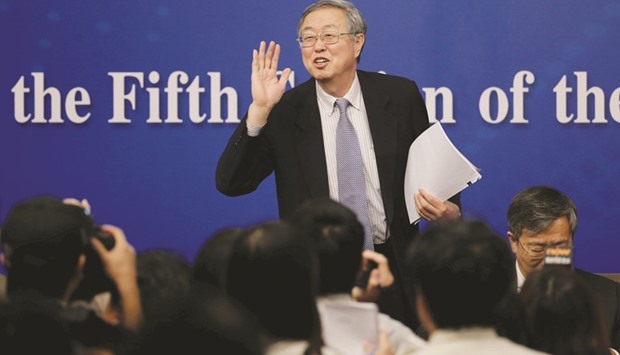Chinese leaders have pledged to contain debt and housing risks in 2017 after years of credit-fuelled expansion, which has been propelled by the need to meet official economic growth targets.
But many analysts remain doubtful over the government’s commitment to follow through on potentially painful reforms, especially if growth falters. “Non-financial corporate leverage is too high,” People’s Bank of China governor Zhou Xiaochuan told reporters at a news conference on the sidelines of the annual parliament session.
Efforts will be made to contain debt levels, including restructuring of firms with heavy debt burdens, alongside a push to reduce excess industrial capacity, he said.
Banks will withdraw support for financially unviable firms, he added, repeating pledges by other officials last year to drive such “zombie” firms out of the market.
“I personally think this process is relatively medium-term. It won’t have very obvious results in the short-term because the existing stock (of debt) is very large,” he said.
Measures by local governments to cool rising house prices will slow mortgage growth to some degree, but housing loans will continue to grow at a relatively rapid pace, Zhou said.
Zhou, 69, took control of the PBoC in 2002 and is the architect of China’s financial reforms.
Throughout the news conference, the jocular governor smiled and amicably engaging with the deputy governors beside him as well as the journalists.
Unlike many government officials, Zhou did not refer to prepared material when responding to questions.
China’s corporate debt has soared to 169% of gross domestic product (GDP), according to figures from the Bank for International Settlements. China needs to first stabilise its overall debt levels before gradually reducing them, deputy central bank governor Yi Gang said at the same briefing.
China’s debt-to-GDP ratio rose to 277% at the end of 2016 from 254% the previous year, with an increasing share of new credit being used to pay debt servicing costs, UBS analysts said in a note. China’s credit growth has been “very fast” by global standards, and without a comprehensive strategy to tackle the overhang, there is a growing risk it will have a banking crisis or sharply slower growth or both, the International Monetary Fund warned late last year.
The central bank’s tilting towards a neutral stance would help with China’s supply-side reforms, Zhou said, reiterating that it would be “prudent” while reminding markets that the central bank has many policy tools at its disposal. In recent months, the PBoC has cautiously moved to a modest tightening bias in a bid to cool explosive growth in debt and discourage speculative activity, though it is treading cautiously to avoid hurting economic growth.
It surprised financial markets by raising short-term interest rates in January and February by marginal amounts, and is expected to bump them higher in coming months, though an increase in its benchmark policy lending rate is seen as unlikely this year.
Beijing has set a more modest economic growth target of around 6.5% this year, easing from last year’s 6.5%-7% range, ostensibly to give policymakers more room to focus on financial risks. The economy ultimately expanded 6.7% last year, but much of the growth came from record lending by state banks and higher government spending on infrastructure, which has helped revived the long ailing and heavily indebted industrial sector.
Bank lending this January was the second highest on record and it did not slow as much as expected in February. “If there is too much money in the economy, in fact it is very harmful to the economy as it might lead to problems such as higher inflation and asset price bubbles,” Zhou said. Turning to the yuan currency, Zhou said market expectations of the yuan’s movements have shown “big changes” this year as China’s economy stabilises.
Zhou said he expected the yuan to be basically stable this year, while conceding that some fluctuations are normal.
Despite repeated interventions by authorities last year, the yuan still fell 6.5% against the dollar. It has steadied early this year as authorities moved to tighten controls on capital outflows and as the dollar’s rally lost steam.
But it started to wilt again in recent sessions on growing expectations that the US central bank will raise interest rates as soon as next week, buoying the dollar.



